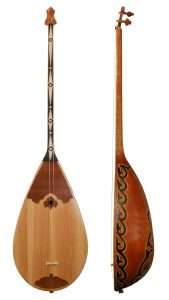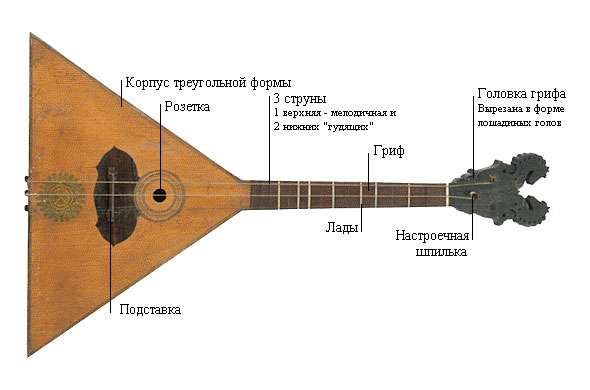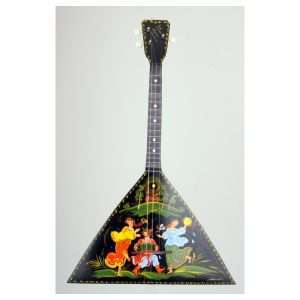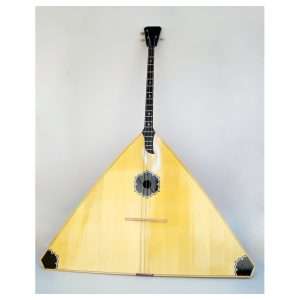
How to choose a balalaika
Contents
Balalaika is a Russian folk stringed musical instrument. The length of balalaikas is very different: from 600-700 mm ( prima balalaika ) to 1.7 meters ( subcontrabass balalaika ) in length, with a triangular slightly curved (also oval in the 18th-19th centuries) wooden case.
The body of the balalaika is glued together from separate (6-7) segments, the head of the long fingerboard a is slightly bent back. Metal strings (In the 18th century, two of them were veined; modern balalaikas have nylon or carbon strings). On the neck of the modern balalaika there are 16-31 metal frets (until the end of the 19th century – 5-7 frets ).
There is no single point of view on the time of the appearance of the balalaika. It is believed that the balalaika has become widespread since the end of the 17th century. Perhaps it comes from the Asian dombra. It was a “long two-stringed instrument, had a body about one and a half spans in length (about 27 cm) and one span in width (about 18 cm) and a neck ( neck ) at least four times longer” (M. Gutry, “Dissertation about Russian antiquities).

Dombra
The balalaika acquired its modern look thanks to the musician-educator Vasily Andreev and the masters V. Ivanov, F. Paserbsky, S. I. Nalimov and others, who in 1883 began to improve it. Andreev V.V. proposed to make a soundboard from spruce, and to make the back of the balalaika from beech, and also shorten it to 600-700 mm. The family of balalaikas made by F. Paserbsky ( piccolo , prima, alto, tenor, bass, double bass) became the basis of the Russian folk orchestra. Later, F. Paserbsky received a patent in Germany for the invention of the balalaika.
The balalaika is used as a solo, concert, ensemble and orchestral instrument. In 1887, Andreev organized the first circle of balalaika lovers, and on March 20, 1888, in the building of the St. Petersburg Mutual Credit Society, the first performance of the Circle of Balalaika Fans took place , which became the birthday of the orchestra of Russian folk instruments.

Balalaika device

Body – consisting of a soundboard (front part) and a back part glued from separate wooden segments. Usually there are seven or six of these segments.
Fretboard – an elongated wooden part, to which the strings are pressed when playing to change the note.
The head is the upper part of the balalaika, where the mechanics and pegs are located , which serve to tune the balalaika.
Tips from the store “Student” for choosing a balalaika
You need to learn to play right away on a good instrument . Only a good instrument can give a strong, beautiful, melodious sound, and the artistic expressiveness of the performance depends on the quality of the sound and the ability to use it.
- The neck of the balalaika should be completely straight, without distortions and cracks, not very thick and convenient for its girth, but not too thin, since in this case, under the influence of external factors (string tension, dampness, temperature changes ) , it can warp over time. The best material for prifa is ebony.
- Frets should be well polished both on the top and along the edges of the neck and not interfere with the movements of the fingers of the left hand.
In addition, all frets must be of the same height or lie in the same plane, i.e., so that the ruler placed on them with an edge touches them all without exception. When playing the balalaika, the strings, pressed at any fret , should give a clear, non-rattling sound. The best materials for frets are white metal and nickel. - String pegs must be mechanical . They hold the system well and allow for very easy and precise tuning of the instrument. That part of the peg, on which the string is wound, should not be hollow, but from a whole piece of metal. The holes into which the strings are passed must be well sanded along the edges, otherwise the strings will quickly fray.
- The soundboard (flat side of the body), built of good resonance spruce with regular, parallel fine plies, should be flat and never bent inwards.
- If there is a hinged shell , you should pay attention that it is really hinged and does not touch the deck. The armor must be made of hard wood (so as not to warp). Its purpose is to protect the delicate deck from shock and destruction.

Balalaika shell
- The top and bottom sills should be made of hardwood or bone to prevent them from wearing out quickly. If the nut is damaged, the strings lie on the neck (on the frets ) and rattle; if the saddle is damaged, the strings can damage the soundboard.
- The stand for the strings should be made of maple and with its entire lower plane in close contact with the soundboard, without giving any gaps. Ebony, oak, bone, or softwood stands are not recommended, as they weaken the sonority of the instrument or, conversely, give it a sharp, unpleasant timbre . The height of the stand is also essential; too high a stand , although it increases the strength and sharpness of the instrument, but makes it difficult to extract a melodious sound; too low– increases the melodiousness of the instrument, but weakens the strength of its sonority; the technique of extracting sound is excessively facilitated and accustoms the balalaika player to passive, inexpressive playing. Therefore, the selection of the stand must be given special attention. A poorly chosen stand can degrade the sound of the instrument and make it difficult to play.
- The buttons for the strings (near the saddle) should be made of very hard wood or bone and sit firmly in their sockets.
- The purity of the system and the timbre of the instrument depends on the selection of strings . Too thin strings give a weak, rattling sound; too thick or make it difficult to play and deprive the instrument of melodiousness, or, not maintaining the order, are torn.
- The sound of the instrument should be full, strong and have a pleasant timbre , devoid of harshness or deafness (“barrel”). When extracting sound from unpressed strings, it should turn out to be long and fade not immediately , but gradually. The sound quality depends mainly on the correct dimensions of the instrument and the quality of the construction materials, bridge and strings.
How to choose a balalaika
Examples of balalaikas
 Balalaika Doff F201 |  Balalaika prima Doff F202-N |
 Bass balalaika Hora M1082 |  Balalaika double bass Doff BK-BK-B |






